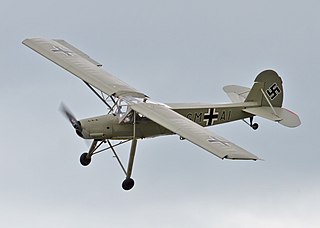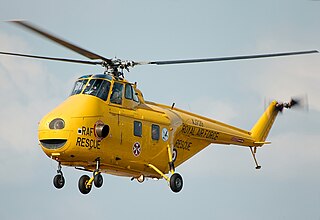Soko was a Yugoslav aircraft manufacturer based in Mostar, SR Bosnia and Herzegovina. The company was responsible for the production of many military aircraft for the Yugoslav Air Force.

The Fieseler Fi 156 Storch was a German liaison aircraft that was built by Fieseler before and during World War II. Production continued in other countries into the 1950s for the private market. It was notable for its excellent short field (STOL) performance and low stalling speed of 50 km/h. French-built later variants often appear at air shows.

The Aermacchi or Macchi MB-326 is a light military jet trainer designed and produced by the Italian aircraft manufacter Aermacchi. It is one of the most commercially successful aircraft of its type, being bought by more than 10 countries and produced under licence in Australia, Brazil and South Africa.

The Northrop GrummanEA-6B Prowler is a twin-engine, four-seat, mid-wing electronic-warfare aircraft derived from the A-6 Intruder airframe. The EA-6A was the initial electronic warfare version of the A-6 used by the United States Marine Corps and United States Navy. Development on the more advanced EA-6B began in 1966. An EA-6B aircrew consisted of one pilot and three Electronic Countermeasures Officers, though it was not uncommon for only two ECMOs to be used on missions. It was capable of carrying and firing anti-radiation missiles (ARMs), such as the AGM-88 HARM.

The Westland Whirlwind helicopter was a British licence-built version of the U.S. Sikorsky S-55/H-19 Chickasaw. It primarily served with the Royal Navy's Fleet Air Arm in anti-submarine and search and rescue roles.

The Sikorsky H-19 Chickasaw is a multi-purpose piston engined helicopter that was used by the United States Army and United States Air Force. It was also license-built by Westland Aircraft as the Westland Whirlwind in the United Kingdom. United States Navy and United States Coast Guard models were designated HO4S, while those of the U.S. Marine Corps were designated HRS. In 1962, the U.S. Navy, U.S. Coast Guard and U.S. Marine Corps versions were all redesignated as H-19s like their U.S. Army and U.S. Air Force counterparts.

The Vultee BT-13 Valiant is an American World War II-era basic trainer aircraft built by Vultee Aircraft for the United States Army Air Corps, and later US Army Air Forces. A subsequent variant of the BT-13 in USAAC/USAAF service was known as the BT-15 Valiant, while an identical version for the US Navy was known as the SNV and was used to train naval aviators for the US Navy and its sister services, the US Marine Corps and US Coast Guard.

The Soko J-22 Orao is a Yugoslav twin-engined, subsonic ground-attack and aerial reconnaissance aircraft. It was developed and built in collaboration by SOKO in Yugoslavia and by Avioane Craiova in neighbouring Romania, being known in the latter as the IAR-93 Vultur.

The Sikorsky H-34 "Choctaw" is an American piston-engined military helicopter originally designed by Sikorsky as an anti-submarine warfare (ASW) aircraft for the United States Navy. It has seen extended use when adapted to turbine power by the British licensee as the Westland Wessex and Sikorsky as the later S-58T.

The Soko G-2 Galeb is a Yugoslav single engine, two-seater jet trainer and light ground-attack aircraft. The G-2 was developed during the 1950s by the Aeronautical Technical Institute at Žarkovo as a replacement for the Lockheed T-33 in service with the Yugoslav Air Force. Production started in 1965 at the Soko aircraft factory in Mostar, and ended in 1985 with 248 aircraft delivered. The G-2 had the distinction of being the first mass-produced jet aircraft in socialist Yugoslavia. It also served as a basis for the single-seat ground-attack J-21 Jastreb.

The de Havilland DH.104 Dove is a British short-haul airliner developed and manufactured by de Havilland. The design, which was a monoplane successor to the pre-war Dragon Rapide biplane, came about from the Brabazon Committee report which, amongst other aircraft types, called for a British-designed short-haul feeder for airlines.

The Westland WS-51 Dragonfly helicopter was built by Westland Aircraft and was an Anglicised licence-built version of the American Sikorsky S-51.

The Air Force and Air Defence, was one of three branches of the Yugoslav People's Army, the Yugoslav military. Commonly referred-to as the Yugoslav Air Force, at its height it was among the largest in Europe. The branch was disbanded in 1992 after the Breakup of Yugoslavia. In the year 1990, the Air Force had more than 32,000 personnel, but as a result of its more technical requirements, the Air Force had less than 4,000 conscripts.

The Percival Pembroke is a British high-wing twin-engined light transport aircraft built by the Percival Aircraft Company, later Hunting Percival.
The 105th Fighter-Bomber Aviation Regiment was an aviation regiment established in 1946 as 3rd Training Aviation Regiment as part of the Yugoslav Air Force.
The 461st Light Combat Aviation Squadron was an aviation squadron of Yugoslav Air Force formed in 1953 at Niš airfield as Training Squadron of 29th Aviation Division.
The 462nd Light Combat Aviation Squadron was an aviation squadron of Yugoslav Air Force formed in 1953 at Rajlovac airfield as Training Squadron of 37th Aviation Division.
The 245th Fighter-Bomber Aviation Squadron was an aviation squadron of Yugoslav Air Force formed in 1953 at Batajnica airfield as Training Squadron of 44th Aviation Division.
The 463rd Light Combat Aviation Squadron was an aviation squadron of Yugoslav Air Force formed in April 1961 at Titograd airfield as part of 105th Training Aviation Regiment. It moved to Zadar military airport Zemunik later the same year.
The 465th Light Combat Aviation Squadron was an aviation squadron of Yugoslav Air Force formed in April 1961 at Mostar airfield as part of 105th Training Aviation Regiment. It has moved to Zadar military airport Zemunik later same year.














